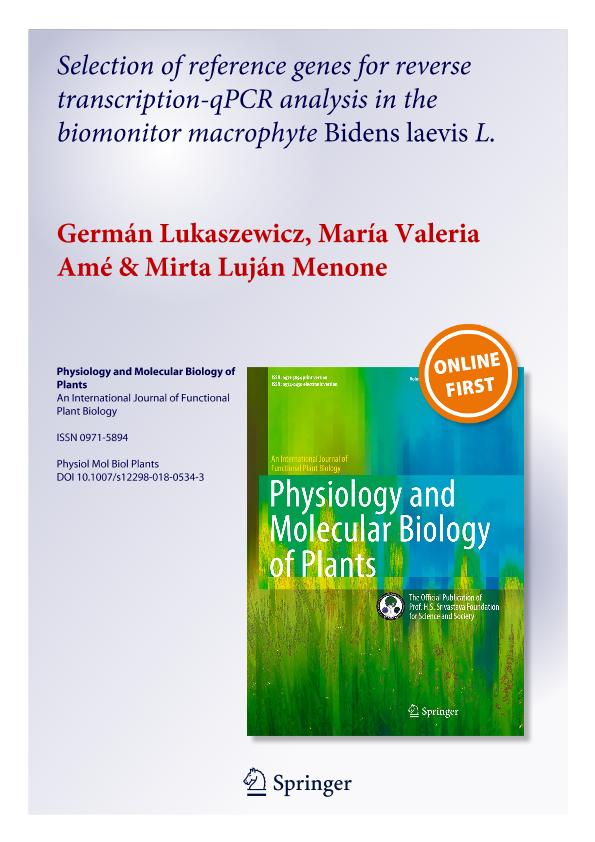Mostrar el registro sencillo del ítem
dc.contributor.author
Lukaszewicz, Germán

dc.contributor.author
Amé, María Valeria

dc.contributor.author
Menone, Mirta Lujan

dc.date.available
2020-01-27T21:36:32Z
dc.date.issued
2018-09
dc.identifier.citation
Lukaszewicz, Germán; Amé, María Valeria; Menone, Mirta Lujan; Selection of reference genes for reverse transcription-qPCR analysis in the biomonitor macrophyte Bidens laevis L.; Springer; Physiology and Molecular Biology of Plants; 24; 5; 9-2018; 781-792
dc.identifier.issn
0971-5894
dc.identifier.uri
http://hdl.handle.net/11336/95931
dc.description.abstract
The RT-qPCR has been the method used to analyze gene expression in plants but its benefits have not been completely exploited in the field of plants ecotoxicology when used as molecular biomarkers. The correct use of RT-qPCR demands to establish a certain number of reference genes (RG) which are expected to be invariable in their expression although it does not always happen. The main goals of this work were to: (1) analyze the stability of six potential RG, (2) establish the optimum number of RG, (3) select the most suitable RG to be applied in Bidens laevis under different test conditions and tissues and (4) confirm its convenience by normalizing the expression of one gene of interest under three different challenges. When all data were pooled together, the geNorm algorithm pointed out beta-actin and beta-tubulin (TUB) as the optimal RG pair while NormFinder algorithm selected nicotinamide adenine dinucleotide dehydrogenase (NADHD) and histone 3 (H3) as possessing the most invariable levels of expression. On the other hand, when data were grouped by tissues, ANOVA test selected H3 and TUB, while data grouped by conditions indicated that H3 and NADHD were the most stable RG under this analysis. Therefore, for a general-purpose set of RG, the overall analysis showed that a set of three RG would be optimum, and H3, TUB and NADHD were the selected ones. On the other hand, as RG can vary depending on the tissues or conditions, results achieved with ANOVA would be more reliable. Thus, appropriate normalization process would clearly need more than one RG.
dc.format
application/pdf
dc.language.iso
eng
dc.publisher
Springer
dc.rights
info:eu-repo/semantics/openAccess
dc.rights.uri
https://creativecommons.org/licenses/by-nc-sa/2.5/ar/
dc.subject
AQUATIC MACROPHYTE
dc.subject
ECOTOXICOLOGY
dc.subject
MOLECULAR BIOMARKERS
dc.subject
REFERENCE GENES
dc.subject
RT-QPCR
dc.subject
XENOBIOTICS
dc.subject.classification
Otras Ciencias de la Tierra y relacionadas con el Medio Ambiente

dc.subject.classification
Ciencias de la Tierra y relacionadas con el Medio Ambiente

dc.subject.classification
CIENCIAS NATURALES Y EXACTAS

dc.title
Selection of reference genes for reverse transcription-qPCR analysis in the biomonitor macrophyte Bidens laevis L.
dc.type
info:eu-repo/semantics/article
dc.type
info:ar-repo/semantics/artículo
dc.type
info:eu-repo/semantics/publishedVersion
dc.date.updated
2019-10-22T16:45:22Z
dc.journal.volume
24
dc.journal.number
5
dc.journal.pagination
781-792
dc.journal.pais
India

dc.journal.ciudad
Nueva Deli
dc.description.fil
Fil: Lukaszewicz, Germán. Consejo Nacional de Investigaciones Científicas y Técnicas. Centro Científico Tecnológico Conicet - Mar del Plata. Instituto de Investigaciones Marinas y Costeras. Universidad Nacional de Mar del Plata. Facultad de Ciencias Exactas y Naturales. Instituto de Investigaciones Marinas y Costeras; Argentina. Consejo Nacional de Investigaciones Científicas y Técnicas. Centro Científico Tecnológico Córdoba. Centro de Investigaciones en Bioquímica Clínica e Inmunología; Argentina
dc.description.fil
Fil: Amé, María Valeria. Consejo Nacional de Investigaciones Científicas y Técnicas. Centro Científico Tecnológico Córdoba. Centro de Investigaciones en Bioquímica Clínica e Inmunología; Argentina
dc.description.fil
Fil: Menone, Mirta Lujan. Consejo Nacional de Investigaciones Científicas y Técnicas. Centro Científico Tecnológico Conicet - Mar del Plata. Instituto de Investigaciones Marinas y Costeras. Universidad Nacional de Mar del Plata. Facultad de Ciencias Exactas y Naturales. Instituto de Investigaciones Marinas y Costeras; Argentina. Consejo Nacional de Investigaciones Científicas y Técnicas. Centro Científico Tecnológico Córdoba. Centro de Investigaciones en Bioquímica Clínica e Inmunología; Argentina
dc.journal.title
Physiology and Molecular Biology of Plants
dc.relation.alternativeid
info:eu-repo/semantics/altIdentifier/doi/http://dx.doi.org/10.1007/s12298-018-0534-3
dc.relation.alternativeid
info:eu-repo/semantics/altIdentifier/url/https://link.springer.com/article/10.1007%2Fs12298-018-0534-3#Abs1
dc.relation.alternativeid
info:eu-repo/semantics/altIdentifier/url/https://www.ncbi.nlm.nih.gov/pmc/articles/PMC6103946/
Archivos asociados
